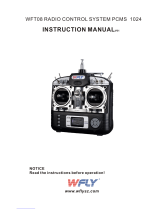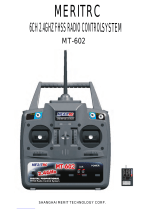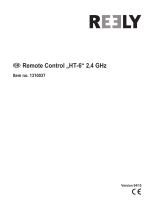
2
Introduction .............................................................3
Service ......................................................................3
Usage Precautions ...................................................4
&RQWHQWVDQGWHFKQLFDOVSHFL¿FDWLRQV ....................8
Transmitter controls .............................................10
Transmitter batteries ............................................12
Switch assignment table .......................................13
Receiver and servo connections ...........................14
Charging batteries ...............................................15
Adjusting the length of the control sticks ...........16
Range check the radio ..........................................17
Radio Installation ..................................................18
Link procedure .....................................................21
S.BUS Installation .................................................22
Transmitter displays & buttons ...........................21
Warning & error displays ....................................24
Map of ACRO functions .......................................26
Programming the T8J-2.4GHz Radio .................27
(Common Functions)
Model Select .....................................................27
Model Copy ......................................................27
Model Data Reset...............................................28
Model Name ......................................................29
Parameter ...........................................................30
Model Type ........................................................30
RX select (S-FHSS /FHSS) ...............................31
ATL ....................................................................32
LCD adjustment .................................................32
Battery Type .......................................................33
Model Data Transmission .................................34
Reverse ..............................................................35
End Point ..........................................................36
Idle Down ..........................................................37
Throttle Cut ........................................................38
D/R,EXP ............................................................39
Timer ..................................................................42
AUX CH ............................................................43
Trainer ................................................................44
Trim....................................................................45
Sub Trim ............................................................46
Servo ..................................................................47
Fail Safe .............................................................48
Flaperon (ACRO Only) .....................................49
Flap Trim (ACRO Only) ....................................51
AIL DIFF (ACRO Only) ...................................52
Elevon (ACRO Only) ........................................53
Ailevator (ACRO Only) ....................................54
V-Tail (ACRO Only) ..........................................55
Snap-Roll (ACRO Only) ...................................56
ELE-FLAP (ACRO Only) .................................59
Airbrake (ACRO Only) .....................................60
THR Needle ..................................................62
THR Delay (ACRO Only) .................................63
THR-Curve (ACRO Only) ................................64
PIT-Curve (ACRO Only) ...................................64
Programmable MIX ...........................................65
G Sens (ACRO Only) ..................................70
Swashplate Types (HELI only) ..........................73
Swash AFR (HELI only) ..................................75
Swash MIX (HELI only) ..................................76
THR MIX (HELI only) .....................................77
Swash Ring (HELI only) ..................................77
Flight Condition<Idle-up,THR-hold> (HELI
only) ...................................................................78
THR Curve (HELI only) ...................................81
PIT Curve (HELI only) .....................................81
REVO.MIX (HELI only) ..................................81
Offset (HELI only) ............................................83
Delay (HELI only) ............................................84
HOV-THR (HELI only) ....................................85
HOV-PIT (HELI only) ......................................85
HI/LO-PIT (HELI only) ....................................86
Gyro (HELI only) .............................................87
Governor (HELI only) ......................................89
TX Setting .........................................................91
TABLE OF CONTENTS
























